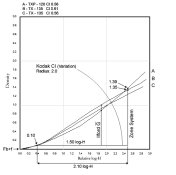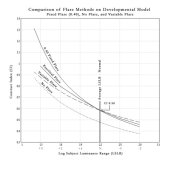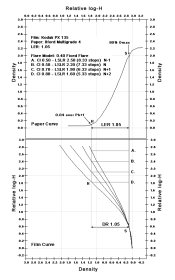smieglitz said:
Stephen,
And now you've sparked my curiosity. Can you explain the relationship between "statistical flare" and contrast index? How is statistical flare determined and related to the CI measurement?
Joe
Flare isn't involved with the determination of Contrast Index, but it does influence everything else. For instance, ISO exposure method incorporates flare into it's determination (flare adds an extra stop of speed under average conditions). With Contrast Index, you want to determine the proper CI for the given conditons. Of course, you determine the desired negative DR with the testing of paper. Most people don't realize that matching the negative to the paper isn't as solid a concept as they think. Jones also did the definitive work on this subject and he concluded, because of the influence of the brightness distribution and subject matter in the scenes photographed, an accurate prediction cannot always be made of the exposure scale (LER) of the paper which will give a first-choice print from a negative of known density scale (DR)
But what other course is there to follow? Either we must make the best of a somewhat imperfect relationship or face the prospect of having no criterion whatever for choosing the paper contrast grade.
The LSLR is determined with your exposure meter, but more importantly is the illuminance range at the film plane. That is really what you are processing for. The problem is flare is next to impossible to determine in the field. In cases such as this, it's best to estimate using a value for the average conditions.
The average luminance range derived from 126 sample scenes used in a study by Lyod Jones at Kodak was 1:160 (2.20 log units), with a standard deviation of 0.38. This means that 68% of the scenes fell within a 2½ stop luminance range of the average, while 95% fell within a 5 stop luminance range. The luminance ranges of the scenes tested were from a minimum 1:27 (1.43 log units, approx. 4⅔ stops) to a maximum 1:750 (2.88 log units, approx. 9½ stops).
The apparent scene luminance range changes within the camera do to the influence of flare. Flare is non-image forming light created by any lens and camera system. Reflections between lens surfaces, lens-to-air surfaces, the sides of the lens (barrow), and the inside of the camera all help to create flare. What flare does is to introduce additional exposure to the film. Flare has a greater influence in the shadow exposure values than with the highlights. This effectively reduces the apparent luminance range of the subject at the film plane. The average value of flare for the statistical average luminance range is 0.34 for large format lenses and 0.40 for small format lenses. The flare effectively reduces the luminance range from 7⅓ stops (log 2.20) to a 6 stops (log 1.80) within the camera (2.20 0.40 = 1.80). Photographic processing is then based on the camera image of 6 stops and not the scene luminance range of 7⅓ stops.
Instead of plugging in 2.2 for CI determination, you plug in 1.80. The equation is expressed as:
CI = Desired Negative Density Range / LSLR - Flare
For a grade 2 with a diffusion enlager, it becomes: 1.05 / 2.2-0.40 = CI 0.58
Projecting it for difference Luminance Ranges and three different flare models:
Dev_____
LSLR____
No Flare____
Fixed Flare____
Variable Flare
-2______2.80______0.30_______0.44____________0.48
-1______2.50______0.42_______0.50____________0.53
N_______2.20______0.48_______0.58____________0.58
+1______1.90______0.55_______0.70____________0.66
+2______1.60______0.66_______0.87____________0.75
+3______1.30______0.81_______1.17____________0.88
Part of the fun is that flare tends to change with differing LSLRs. It increases as the LSLR increases and decreases as the LSLR decreases. You can see how it tends to temper the necessary range of processing. The question is which is the most accurate. Any scene can produce a variety of flare depending on the size and distribution of tones. This is a variable that, for the most part, cannot be controlled.
One thought comes from Jones' observations about the matching of the negative to the paper. Jones concluded that, even though matching the negative DR to the paper LER isnt a perfect criterion, it is good enough to produce quality images in most situations, or at least with a slight contrast adjustment. Jones also found a few exceptions to the DR / LER criteria, for the soft papers, the density scales of the negative (DR) should in most cases exceed the sensitometric exposure scale of the paper (LER), whereas, for the hard papers, the density scales of the negatives should in most cases be less than the sensitometric exposure scale of the paper (LER).
Are these exceptions enough to cover the variable flare method if or when it falls short? My personal feeling is to introduce another method which I call the "practical flare method." It basically is the mean between the fix 0.40 flare model and the variable flare model. I've attached a graphic depiction of the various flare methods.
I hope this is what you are looking for.
Sandy, I think I got it from:
"But a film that has received no exposure can not be developed to a CI of anything other than 0.00 because it can never, for all practical purposes, have any slope."










